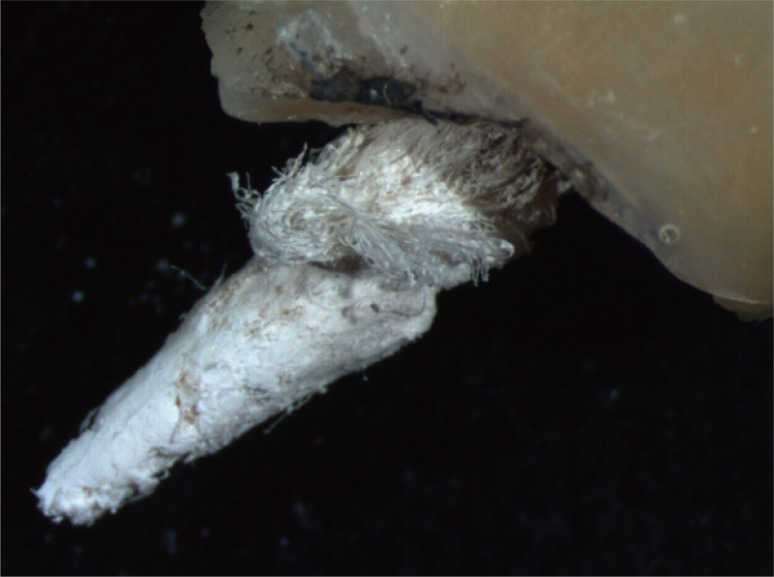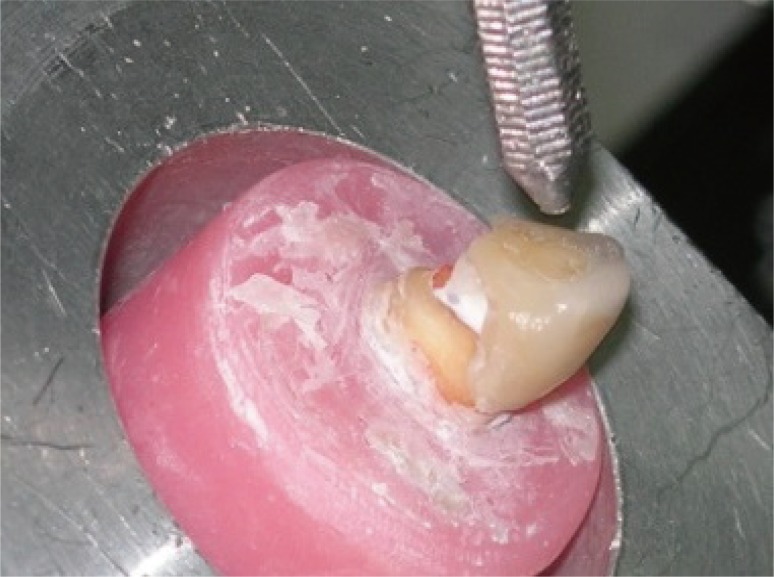1. Robbins JW. Restoration of the endodontically treated tooth. Dent Clin North Am. 2002; 46:367–384. PMID:
12014038.
2. Torbjörner A, Karlsson S, Odman PA. Survival rate and failure characteristics for two post designs. J Prosthet Dent. 1995; 73:439–444. PMID:
7658393.

3. Viguie G, Malquarti G, Vincent B, Bourgeois D. Epoxy/carbon composite resins in dentistry: mechanical properties related to fiber reinforcements. J Prosthet Dent. 1994; 72:245–249. PMID:
7965896.

4. Lima AF, Spazzin AO, Galafassi D, Correr-Sobrinho L, Carlini-Júnior B. Influence of ferrule preparation with or without glass fiber post on fracture resistance of endodontically treated teeth. J Appl Oral Sci. 2010; 18:360–363. PMID:
20835570.

5. Lassila LV, Tanner J, Le Bell AM, Narva K, Vallittu PK. Flexural properties of fiber reinforced root canal posts. Dent Mater. 2004; 20:29–36. PMID:
14698771.

6. Maroulakos G, Nagy WW, Kontogiorgos ED. Fracture resistance of compromised endodontically treated teeth restored with bonded post and cores: An in vitro study. J Prosthet Dent. 2015; 114:390–397. PMID:
26047799.
7. Bateman G, Ricketts DN, Saunders WP. Fibre-based post systems: a review. Br Dent J. 2003; 195:43–48. discussion 37PMID:
12856030.

8. Fragou T, Tortopidis D, Kontonasaki E, Evangelinaki E, Ioannidis K, Petridis H, Koidis P. The effect of ferrule on the fracture mode of endodontically treated canines restored with fibre posts and metal-ceramic or all-ceramic crowns. J Dent. 2012; 40:276–285. PMID:
22265988.

9. Duret B, Duret F, Reynaud M. Long-life physical property preservation and postendodontic rehabilitation with the Composipost. Compend Contin Educ Dent Suppl. 1996; 20:S50–S56. PMID:
12089762.
10. Fredriksson M, Astbäck J, Pamenius M, Arvidson K. A retrospective study of 236 patients with teeth restored by carbon fiber-reinforced epoxy resin posts. J Prosthet Dent. 1998; 80:151–157. PMID:
9710815.

11. Ferrari M, Vichi A, Mannocci F, Mason PN. Retrospective study of the clinical performance of fiber posts. Am J Dent. 2000; 13:9B–13B.
12. Balbosh A, Kern M. Effect of surface treatment on retention of glass-fiber endodontic posts. J Prosthet Dent. 2006; 95:218–223. PMID:
16543019.

13. Rudo DN, Karbhari VM. Physical behaviors of fiber reinforcement as applied to tooth stabilization. Dent Clin North Am. 1999; 43:7–35. PMID:
9929797.
14. Turker SB, Alkumru HN, Evren B. Prospective clinical trial of polyethylene fiber ribbon-reinforced, resin composite post-core buildup restorations. Int J Prosthodont. 2007; 20:55–56. PMID:
17319364.
15. Turner CH. Cement distribution during post cementation. J Dent. 1981; 9:231–239. PMID:
7024356.

16. Mendoza DB, Eakle WS, Kahl EA, Ho R. Root reinforcement with a resin-bonded preformed post. J Prosthet Dent. 1997; 78:10–14. PMID:
9237140.

17. Mannocci F, Ferrari M, Watson TF. Intermittent loading of teeth restored using quartz fiber, carbon-quartz fiber, and zirconium dioxide ceramic root canal posts. J Adhes Dent. 1999; 1:153–158. PMID:
11725680.
18. Stockton LW. Factors affecting retention of post systems: a literature review. J Prosthet Dent. 1999; 81:380–385. PMID:
10095205.

19. Sahafi A, Peutzfeldt A, Asmussen E, Gotfredsen K. Retention and failure morphology of prefabricated posts. Int J Prosthodont. 2004; 17:307–312. PMID:
15237877.
20. Cohen BI, Condos S, Deutsch AS, Musikant BL. Fracture strength of three different core materials in combination with three different endodontic posts. Int J Prosthodont. 1994; 7:178–182. PMID:
8003200.
21. Yaman P, Thorsteinsson TS. Effect of core materials on stress distribution of posts. J Prosthet Dent. 1992; 68:416–420. PMID:
1432754.

22. Sadek FT, Monticelli F, Goracci C, Tay FR, Cardoso PE, Ferrari M. Bond strength performance of different resin composites used as core materials around fiber posts. Dent Mater. 2007; 23:95–99. PMID:
16434092.

23. Isidor F, Brøndum K, Ravnholt G. The influence of post length and crown ferrule length on the resistance to cyclic loading of bovine teeth with prefabricated titanium posts. Int J Prosthodont. 1999; 12:78–82. PMID:
10196832.
24. Sokol DJ. Effective use of current core and post concepts. J Prosthet Dent. 1984; 52:231–234. PMID:
6381706.

25. Standlee JP, Caputo AA, Holcomb J, Trabert KC. The retentive and stress-distributing properties of a threaded endodontic dowel. J Prosthet Dent. 1980; 44:398–404. PMID:
6997468.

26. Holmes DC, Diaz-Arnold AM, Leary JM. Influence of post dimension on stress distribution in dentin. J Prosthet Dent. 1996; 75:140–147. PMID:
8667271.

27. Sirimai S, Riis DN, Morgano SM. An in vitro study of the fracture resistance and the incidence ofvertical root fracture of pulpless teeth restored with six post-and-coresystems. J Prosthet Dent. 1999; 81:262–269. PMID:
10050112.
28. Kelly JR. Approaching clinical relevance in failure testing of restorations. J Prosthet Dent. 1999; 81:652–661. PMID:
10347352.
29. Assif D, Bitenski A, Pilo R, Oren E. Effect of post design n resistance to fracture of endodontically treated teeth with complete crowns. J Prosthet Dent. 1993; 69:36–40. PMID:
8455166.
30. Pereira JR, de Ornelas F, Conti PC, do Valle AL. Effect of a crown ferrule on the fracture resistance of endodontically treated teeth restored with prefabricated posts. J Prosthet Dent. 2006; 95:50–54. PMID:
16399275.

31. Cormier CJ, Burns DR, Moon P. In vitro comparison of the fracture resistance and failure mode of fiber, ceramic, and conventional post systems at various stages of restoration. J Prosthodont. 2001; 10:26–36. PMID:
11406793.

32. Al-Wahadni AM, Hamdan S, Al-Omiri M, Hammad MM, Hatamleh MM. Fracture resistance of teeth restored with different post systems: in vitro study. Oral Surg Oral Med Oral Pathol Oral Radiol Endod. 2008; 106:e77–e83. PMID:
18554954.

33. Stricker EJ, Göhring TN. Influence of different posts and cores on marginal adaptation, fracture resistance, and fracture mode of composite resin crowns on human mandibular premolars. An in vitro study. J Dent. 2006; 34:326–335. PMID:
16202498.

34. Akkayan B. An in vitro study evaluating the effect of ferrule length on fracture resistance of endodontically treated teeth restored with fiber-reinforced and zirconia dowel systems. J Prosthet Dent. 2004; 92:155–162. PMID:
15295325.

35. Tan PL, Aquilino SA, Gratton DG, Stanford CM, Tan SC, Johnson WT, Dawson D. In vitro fracture resistance of endodontically treated central incisors with varying ferrule heights and configurations. J Prosthet Dent. 2005; 93:331–336. PMID:
15798683.

36. Eskitaşcioğlu G, Belli S, Kalkan M. Evaluation of two post core systems using two different methods (fracture strength test and a finite elemental stress analysis). J Endod. 2002; 28:629–633. PMID:
12236304.
37. Giovani AR, Vansan LP, de Sousa Neto MD, Paulino SM. In vitro fracture resistance of glass-fiber and cast metal posts with different lengths. J Prosthet Dent. 2009; 101:183–188. PMID:
19231570.

38. de Oliveira JA, Pereira JR, Lins do, Zogheib LV. Fracture resistance of endodontically treated teeth with different heights of crown ferrule restored with prefabricated carbon fiber post and composite resin core by intermittent loading. Oral Surg Oral Med Oral Pathol Oral Radiol Endod. 2008; 106:e52–e57. PMID:
18718775.

39. Ma PS, Nicholls JI, Junge T, Phillips KM. Load fatigue of teeth with different ferrule lengths, restored with fiber posts, composite resin cores, and all-ceramic crowns. J Prosthet Dent. 2009; 102:229–234. PMID:
19782825.

40. Goodacre CJ, Campagni WV, Aquilino SA. Tooth preparations for complete crowns: an art form based on scientific principles. J Prosthet Dent. 2001; 85:363–376. PMID:
11319534.

41. Kovarik RE, Breeding LC, Caughman WF. Fatigue life of three core materials under simulated chewing conditions. J Prosthet Dent. 1992; 68:584–590. PMID:
1403934.

42. Lyons MF, Baxendale RH. A preliminary electromyographic study of bite force and jaw-closing muscle fatigue in human subjects with advanced tooth wear. J Oral Rehabil. 1990; 17:311–318. PMID:
2213325.

43. Marchionatti AM, Wandscher VF, Broch J, Bergoli CD, Maier J, Valandro LF, Kaizer OB. Influence of periodontal ligament simulation on bond strength and fracture resistance of roots restored with fiber posts. J Appl Oral Sci. 2014; 22:450–458. PMID:
25466478.










 PDF
PDF ePub
ePub Citation
Citation Print
Print










 XML Download
XML Download